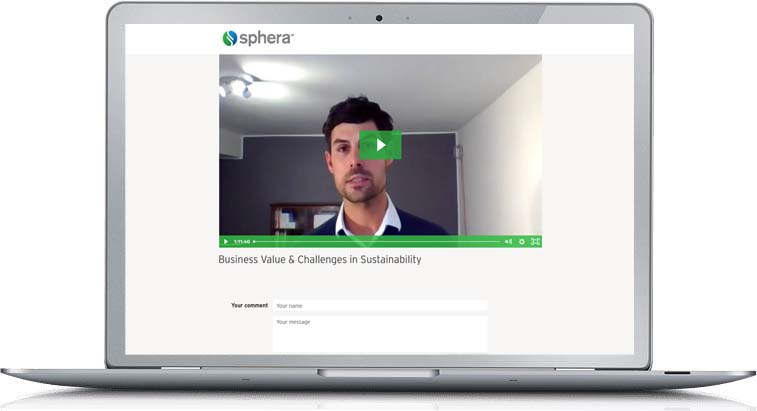Sustainability tactics to consider, whether you work for a large company or a small to medium-sized business. An interview with Hannes Partl, principal consultant.
In your view, what is the definition of a sustainability strategy?
Sustainability is an all-encompassing term. It can mean different things to different people and different organizations. In a nutshell, I would say that sustainability strategy means that an organization has at least a general idea or a rough plan of how to align non-financial aspects with their commercial practices in a way so that they derive a business benefit. They have a sustainability strategy if they are convinced that improved sustainability performance, environmental or social performance, will be a business advantage in the medium to long-term.
So strategy puts sustainability into the field of business. Is it correct to say that a strategy can be called a strategy when the economic element dovetails with the two other pillars of sustainability: environmental and social?
Yes, that’s what I mean with a real sustainability strategy. The focus areas are, of course, environmental and social. When a company has found a compelling way to combine all three to their advantage, then the sustainability goals are aligned with the business. Some companies create a sustainability strategy, because they want to show that they are “a little bit green,” or “a little bit sustainable.” Those companies are not convinced that it helps them commercially. But a real strategy must combine all three aspects.

Can you point out some mainstream approaches companies take with their sustainability strategies?
By far the most common approach is greenhouse gas or carbon reporting and sometimes the management of these emissions, but for many it is often just reporting, and many times just Scope 1 and 2 reporting, without Scope 3. It’s just reporting without any serious ambition to improve and reduce—to manage—the emissions and get them aligned with commercial goals. We often see that sustainability in general is reduced to carbon reporting and emissions reporting and that’s it. While some companies are really taking this seriously, others just do it for a few numbers, because they think it’s what a company should do nowadays.
Could we call it “the strategy that is not a strategy”?
Yes, in a way. Some companies start with greenhouse gas reporting and management, and they really want to do something. They want to improve and use those improvements to their commercial advantage. Then it’s great—it’s a starting point to build from. But when you do it only because you think you have to do it, well, we could call that the cheap and dirty version.
The other mainstream approach is when a company takes the issue more seriously, when it starts with a kind of materiality assessment to find out what is relevant to them and to stakeholders outside of the company. This is a proof of serious intention for sustainable development. It shows a willingness to make sustainability an integral part of the business strategy.

Would you recommend this last approach then?
You can always start from different points, but in my view—especially if a company starts from scratch—a materiality assessment is a very good way of building up a sustainability strategy.
With regard to sustainability reporting, many small and medium-sized companies think that a sustainability strategy is just something for the “big boys.” Do you agree? If you don’t, how should small and medium-sized businesses with limited resources approach this topic?
Strategy can mean many different things to many different people. Like if you ask, “How long is this piece of string?” You’re going to get different answers depending on who you ask. Strategy can be very succinct and simple and still very successful. Of course, for a large company, strategy requires a substantial amount of analysis and thinking, involvement from a wide range of people and business units, suppliers and clients. But for a small to medium-sized company, a sustainability strategy doesn’t have to be complex to still be very effective. It can start from a simple intention, like the improvement of your brand through promoting the sustainability performance of products.
‘A materiality assessment is a very good way of building up a sustainability strategy.’
Is there a way for SMEs to bypass working incrementally in their sustainability activities? How can they align their sustainability activities more efficiently, to build a strategical sequence with a long-term vision? Do you have any tips for how to start?
I think the main word is vision. With large companies and big sustainability strategies, sometimes it’s a major undertaking to develop the vision—to determine where a company wants to be and what role sustainability should play in their game. For a small company, the vision could also be a manager saying, “I want my company to be more successful by being more sustainable,” and he or she might know exactly how to get there, with a realistic vision for the work required to determine which steps need to be taken. In the case of a smaller company, it’s much easier to identify the pathways to implementing a strategy. Whereas with a large company, there is much more involved, and it’s a complex process that can take six months or even a year. Tools and consultancy services can be useful also for SMEs, but a simplified materiality assessment can also work well—three or four bright minds together that give their input and help decide what is relevant and how much positive impact the company can make in different areas.
If there is no vision, then sustainability will always only be a byproduct. Without a vision, things run in parallel. We can only speak about vision and strategy when they are together and aligned based on a real understanding of the potential for improved sustainability performance.
Where do companies usually fail? What are the typical pitfalls?
I think the biggest challenge is to develop a strategy in which a sustainable way is found within the company to develop a more competitive edge. The company needs to be convinced that sustainability is a more successful way of doing business. Many companies fail to find or fully understand the connection. Management plays a key role here. If the top management isn’t behind it, the company will never leverage sustainability to its full potential.
Another factor for failure is misguided communication or a lack of communication. If the vision and the strategy are not communicated at all levels within an organization over time, then the transition takes longer or can even fail, because the people who work there are not behind it or don’t understand why sustainability is being pushed. If there’s no understanding, the quality and outcome of actions will always be poorer.
How would you then summarize the key to a successful sustainability strategy?
We can draw the conclusion that the key to success is to first have a clear vision. Second, convince top management. Third, communicate efficiently at all levels within an organization and, lastly, make a fundamental connection between the sustainability strategy and the overall business strategy.
‘The company needs to be convinced that sustainability is a more successful way of doing business. Many companies fail to find or fully understand the connection.’
Do you think there is an ideal starting point for the development of a sustainability strategy? If a company is starting from scratch, what’s the ideal starting point?
Ideally it would always be the engagement of top management. In my experience, many times people at the middle management level are on board, but it’s very hard, and it takes a lot of effort to convince C-level to get behind the case and make resources available. Otherwise, I think there’s no recipe that is valid for everybody—it depends on the type of company and its strengths and weaknesses. There’s no rule that says you should always start with the product or with corporate sustainability. But it must be connected to business success. A general rule could be, first develop the vision, then understand, analyze and measure and after that you can have a goal for where you want to end up, along with different targets along the way to getting there.
How to Build Your Sustainable Business Strategy
Is there a universal topic that every organization should focus on? For example, recently I read an article that said, “We need all our energy, resources and focus on climate change. Talk about nothing else, to your board, investors, political connections and customers. Measure your success in $ and tons CO2. If we beat climate change, we will automatically make many of the other problems better.” Do you agree?
I don’t think this is the only universal topic. For larger corporations some of the social aspects of sustainability are essential and need to be addressed as well. In environmental terms, I think greenhouse gas reporting and management is a good start. At the product and corporate level as well, it’s a pretty good indicator, and it is relatively easy to understand. And this is important. It can get the company to think about their place in the value chain and how to engage with their suppliers, how to improve themselves and the supply chain and how to better manage risks.
Is there a framework or initiative that could support any company in the development of a sustainability strategy? Guidelines that everybody can benefit from.
If a company is looking to orient itself and trying to determine the potential aspects that it may not be familiar with, then, in my view, GRI [Global Reporting Initiative] is a great guideline for large companies and SMEs as well. It has different levels of reporting and sustainability management, so companies don’t need to start at a very ambitious level. It gives companies good insight into what may be relevant and what is seen as relevant by other companies and how those companies approach such topics. The other framework I would recommend for larger companies is the CDP [Carbon Disclosure Project], which originally focused on carbon management and reporting and over time has grown to address other areas as well, such as water and forest programs. Their rating systems, in terms of quality of reporting and management, give a good indication to corporations of answers to questions like, “Where do I stand? What can I do? What are the potentials?”
You said that ideally sustainability strategy should be developed top-down. But what if a CEO has a vision, but doesn’t have the expertise? Yet he or she takes the lead of a company that without a sustainability strategy?
I would try to find an external senior sustainability expert to start a dialog with. This dialog is essential. The CEO understands how the company operates. The experienced sustainability professional knows what is possible, what can be done from a sustainability point of view, and can tell whether there is any possibility of doing it. That’s why I enjoy working at Sphera, and I love what I do—to bring quantification and substance into sustainability, thereby enabling companies to succeed sustainably. It’s important to make decisions and develop a strategy on the basis of accurate evaluation. The “make us green” motto doesn’t work. Without substance, “sustainability” is just a lie and at that point it’s better for the company to do and say nothing related to sustainability. The only thing that such greenwashing brings is it increases awareness about sustainability as a general topic, but if a company has no substance behind its claims, eventually the truth will come out in the open, and then they’ll have a branding crisis on their hands.
Without substance, “sustainability” is just a lie and at that point it’s better for the company to do and say nothing related to sustainability.
Let’s look at this from a different angle. How can sustainability professionals drive the sustainability strategy bottom-up? How can they get unreceptive and uninterested management involved?
They must build a business case around a certain sustainability topic. That’s the only way to do it, and that’s why I was so adamant in saying at the beginning that sustainability is not just an add-on. It needs to be—or become—an essential part of the business.
Unfortunately, improved environmental performance is just not convincing enough. Getting the buy-in from sales and marketing people can be decisive. If they understand the business potential of sustainability, they can successfully support sustainability, often much better than R&D professionals who are more driven only by the wish to do better.
Could you share with us a success story that is a good example of a sustainability strategy path for a company that you supported?
Of course. There are many case studies, but I would like to mention the example of Giesecke and Devrient, a corporation we have been working with for more than 10 years. They started wanting to do something in the field of sustainability, and they asked us how to go about it. We began with a few meetings, involving people from different business units. They shared their ideas and their challenges convincing top management about the business benefits of taking action. So, we developed carbon reporting with them, first Scope 1 and 2 and later Scope 3 as well, and a strategy around it.
The next step was that they committed to reporting to the CDP. We created a benchmarking framework for their industry sector to understand what the competition was doing. Using these elements as a basis, we developed a more involved sustainability strategy and set related targets. Having a clearer understanding of how these sustainability actions and targets could be utilized from a commercial perspective, we jointly took the learnings to their board.
One of the keys to winning them over was to show statistics. For example, we showed how the improved financial performance of CDP reporters compared to their non-reporting peers. The company moved forward along its sustainability path. It developed environmental footprints for a key product group, which then helped them to win bids. So by gradually scaling up, their sustainability efforts developed into a wider sustainability strategy and implementation plan that has become an integral part of their business.
Anything else you’d like to add?
I’d just add that it’s great to see a fairly steep increase in the numbers of companies that are getting serious about sustainability. And it’s great to be able to work with a few of those and contribute to two things at the same time: their long-term success and a more sustainable planet.





